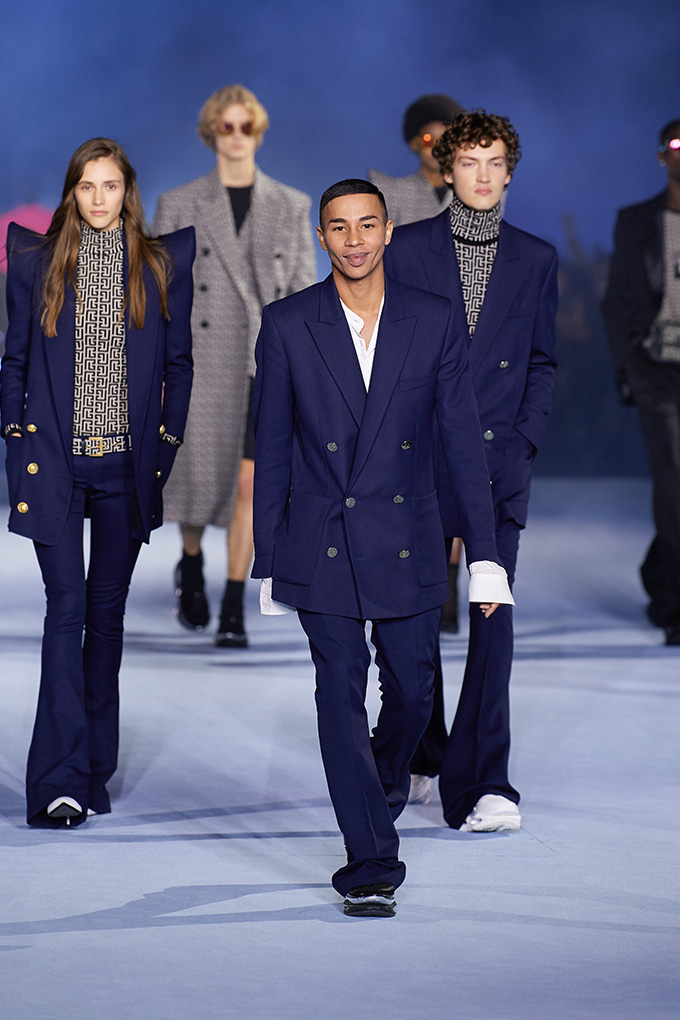For his first Balmain show in Paris after lockdown—and his first co-ed production—Olivier Rousteing wanted to capture the resourceful post-war spirit on which Pierre Balmain built his house. He dug into the archives, brought back key elements, and soldiered on with his encouraging take on glamour for the post-pandemic fashion world. Knowing he wouldn’t be able to have the illustrious front row that normally frequents his shows, the designer asked editors and friends—from Jennifer Lopez to Cindy Crawford and Kris Jenner—to film themselves pretending to be watching the show. On his runway in Jardin des Plantes, Rousteing lined up three rows of screens with their faces on them and looped their clips throughout the show. For those of us who were there in person, it was almost as if they were, too.
Why did you come up with featuring editors on screens?
I struggled a lot during this COVID time to understand if we should do everything digitally. Was it right, was it wrong? For me, without the physical experience, without having you to talk to, it’s really hard. It’s hard for a designer to create without an audience.
How did you select who to feature on the screens?
All the editors you see on those screens have supported me historically. As a designer, fashion critique is important to me: growing and being challenged. I was so happy that everyone wanted to be a part of it.
What created this collection?
It’s about optimism. Colours. It’s inspired by the heritage of Monsieur Balmain: bringing back the heritage of the house, a house that was built in 1945. In lockdown, I thought about what the future was going to be like, and for me, you can’t understand the future without understanding the past.

What was that process like?
Bringing back the archives of Monsieur Balmain was super inspiring for me, because I’m know for pop culture but sometimes not for French classicism. It’s this Saint Germain feeling that Monsieur Balmain had; super French. But at the same time, he was super international. I was listening to interviews of his from the 1960s. He was speaking fluent English, which is something that was pretty inspiring for a designer from that time to do.
What’s the message behind the collection?
I was inspired by a sense of community. In lockdown, my team and I were working all together with our suppliers from different parts of the world. I call this collection ‘Saint Germain in the ‘70s meets The Bronx in the ‘90s’. It’s my French obsession meeting my pop culture. These flared trousers could be Serge Gainsbourg… or they could be Britney Spears! JLo!
What does that mean to you?
It’s the shock of two cultures. When you’re French, you’re often part of one circle, but it’s also about being proud of your pop culture and the culture of your childhood.
Is the pagoda shoulder back?
Yes, this my lockdown moment when I realised we all dressed not head-to-toe but head-to-waist. Half of my team was dressed like that, and then jogging pants… they tell me. At Balmain, tailoring is our best-seller and what we’re known for, so the architecture of the jacket was important to bring back.
Why did you choose to launch your new archival logo now?
For me it was important to remind a people that Balmain is a house that slept for many decades. Monsieur Balmain had an incredible archive that people might not know. I would never believe, if I was born in the 1940s or 70s, that I could be the leader of a French luxury house like this. I want to bring back those archives and say, ‘Now, I’m the leader of these elements.’ I want the next generation to know the power of Balmain in years to come.
This article was originally published on British Vogue.

















